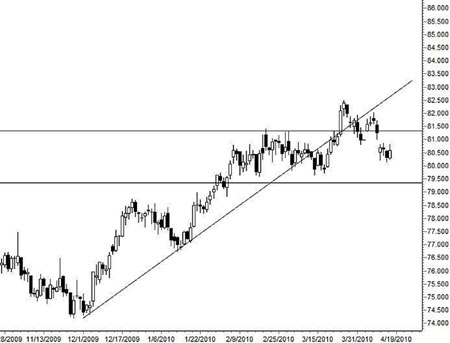Daryl Guppy
US dollar shows signs of potential development
By Daryl Guppy (China Daily)
Updated: 2010-04-19 10:10
 |
Large Medium Small |
The meeting on the sidelines of the Nuclear Security Summit conference between President Hu Jintao and US President Barack Obama discussed the relative value of the yuan and the dollar. It took place against an interesting background in currency markets where opinion is supported by real money. In the last few days money has been walking away from the US Dollar.

The US dollar index is a measure of the currency's strength or weakness. During the last week it has plunged from $0.82 to near $0.805. The move above $0.82 had the potential to develop a uptrend move to $0.85. This failed to develop. The dollar index failed to sustain the upward momentum. It fell below the most recent up trend line starting in December 2009. Recently a weak rebound developed from near $0.81 but the uptrend line now acted as a resistance level. The dollar retreated quickly from this level showing a potential to retest support near $0.795.
This behavior signals several potential developments.
First, this confirms the volatility of the US dollar. Long and stable trends are a thing of the past. The US dollar has become a floating currency with relatively short-term trending behavior. The rally and retreat levels are substantial ranging in $0.04 and $0.05 moves. These do not sound significant, but in terms of currency behavior they represent a high level of volatility.
Volatility is a nightmare for exporters and importers unless they are very competent at hedging their currency exposure. Many US importers have yet to become accustomed to US dollar volatility, so they are inclined to blame their problems on others.
Second is the potential to develop another significant downtrend with a move below $0.795. A failure of support at this level leads to a retest of lows near $0.765 and potentially the previous lows near $0.745.
The April to June 2009 retreat saw a $0.10 drop in the Dollar index from $0.87 to $0.77 and there is no chart-based reason why this could not be repeated.
Weakness is the US dollar has the effect of increasing the competitiveness of US exports. From 2006 to 2007, and again from March to December 2009, the US dollar fell dramatically. It is the rise of the US dollar for the first 3 months of 2010 that has had a significant impact on US exports.
The US Federal Reserve has total control of the supply of US dollars and this gives it dominant influence over the value of the US dollar and in turn, the terms of trading for its trading partners. The prolonged low interest rate environment keeps downwards pressure on the US dollar.
It is convenient to point a finger at the yuan, but the behavior of the US dollar index suggests there are other more powerful forces at play in determining the valuation of the US dollar, and ultimately the business prospects of US exporters and importers.
| ||||
This pattern starts with a rally and retreat which is followed by a rally to new highs and then a substantial retreat. The left shoulder is potentially created by the rally to $0.81 and the retreat to $0.79. The head is potentially created by the rally from $0.79 to $0.825 and the current retreat to $0.80. The pattern is completed by a new rally that does not exceed $0.82 followed by a retreat that moves below $0.80.
The author is a well-known financial technical analyst














